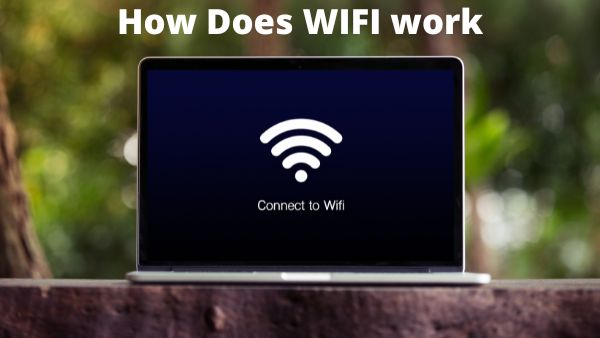How Does WIFI work

How Does WIFI work- Have you ever wondered how exactly streaming video or email can be accessed so fast, easily, and in real time on your tablet or smartphone? Wi-fi is being used there. Tech Talker explores the technologies underlying wireless devices this week.
Imagine a day without WiFi. Tough, right? That’s because WiFi, or Wireless Fidelity, has become a crucial part of our daily lives. It’s like the invisible magic that connects our devices to the internet, allowing us to browse, stream, download, and upload at the click of a button. But have you ever wondered how this magic works? Let’s unravel the mystery together!
In the simplest terms, WiFi is a technology that uses radio waves to provide network connectivity. It’s like how your radio catches music signals from the air; only here, the signals carry internet data. Cool, isn’t it?
What Is WiFi?
Let’s start by going over some fundamentals. WLAN, which stands for “Wireless Local Area Network,” is the same as WiFi, which stands for “Wireless Fidelity.”
Understanding the Basics
Let’s start with the basics. WiFi operates on a principle you might already be familiar with – radio waves. Yes, the same radio waves that bring music to your car’s radio! But instead of music, WiFi transmits data.
Similar to other wireless technology, WiFi transmits signals between devices using radio waves. When compared to walkie-talkies, vehicle radios, cell phones, and weather radios, the radio frequencies are radically different. In contrast to WiFi, which transmits and receives data as in Gigahertz range, your car audio, for instance, receives frequencies in the Kilohertz as well as Megahertz range (AM and FM stations).
How Does WIFI work
Here’s how it works: Your WiFi router, which is connected to the internet, converts this data into a radio signal. This signal is then broadcasted out to your devices like your laptop, smartphone, or smart TV. These devices catch the signal, allowing you to view web pages, stream videos, or play online games. It’s like your device and the router are having a continuous conversation in a language of radio waves!
Even more simply put, a Hertz (Hz) is a frequency measurement unit. Imagine that you are watching the waves crest while perched on a pier. The peak of each wave may be seen as you glance down at the waves. The frequency of the waves can be determined by counting the number of secs between each wave crest. The frequency of the wave would therefore be 1 hertz, or one cycle per sec, if the interval between each peak was 1 sec.
When compared to sea waves, Mhz as well as Ghz move through the air at 1 million as well as 1 billion cycles per second! Your radio receiver also needs to be tuned to a specific frequency if you want to be able to hear the information carried by these waves.
This frequency occurs to be 2.4 and 5 GHz for WiFi. The frequency of these waves is extremely similar to that of your microwave. While your network uses 2.412 GHz to 2.472 GHz to send data over WiFi, your microwave uses 2.450 GHz to heat food. This is why some users who attempt to make popcorn in outdated or malfunctioning microwaves encounter a WiFi signal issue.
Just to dispel a common misunderstanding, these microwaves do not emit ionising radiation. As a result, they cannot cause cancer. Yes, microwaves won’t turn you radioactive and shine in the dark.
Learn the essential steps on how to kick off other devices from your WiFi network with our comprehensive guide, ensuring a secure and optimized internet experience. Check it out now!
WiFi Standards
You might have noticed different numbers and letters associated with WiFi, like 802.11g, 802.11n, or 802.11ac. These are actually WiFi standards, set by the Institute of Electrical and Electronics Engineers (IEEE). Each standard operates on a different frequency, offers different speeds, and works best at a certain range.
For instance, the older 802.11a and 802.11b standards operate at a frequency of 2.4GHz, which is great for range but not so much for speed. Then came 802.11g and 802.11n, offering faster speeds and better performance. The latest standard, 802.11ac, operates at 5GHz and provides even faster data rates.
It’s important to note that the speed of your WiFi also depends on your internet service provider. So, even if you have a router that supports 802.11ac, you won’t get those high speeds if your internet plan doesn’t support it.
WiFi Network Components
Now that we’ve understood the basics and the standards, let’s look at the key players in a WiFi network – the router and the network adapter.
The router is like the heart of your WiFi network. It’s connected to the internet (usually via a modem) and broadcasts this connection as a WiFi signal. Your devices pick up this signal and voila, you’re connected to the internet!
But how do your devices pick up this signal? That’s where the network adapter comes in. It’s a hardware component in your device that receives the WiFi signal from the router. It’s like the router and your device are playing catch with the internet data!
The WiFi Connection Process
Connecting to a WiFi network is a process we often take for granted, but there’s a lot happening behind the scenes. Let’s break it down!
When you turn on WiFi on your device, it sends out a signal asking for available networks. The router responds with its Service Set Identifier (SSID), which is the name you see in your list of available networks.
Once you select a network, you’re usually asked for a password. This password is part of the network’s security protocol, which encrypts the data sent between your device and the router. Once you enter the correct password, your device and the router exchange a hearty handshake, and you’re connected!
WiFi Security
In a world where data is the new gold, WiFi security is more important than ever. It’s what keeps your personal information safe when you’re browsing the internet.
There are several security protocols that WiFi networks can use, including WEP (Wired Equivalent Privacy), WPA (WiFi Protected Access), and WPA2. These protocols encrypt the data that is sent between your device and the router, making it harder for anyone else to access it.
WEP is the oldest and the least secure of the three. WPA improved upon WEP, and WPA2 is currently the most secure option. When setting up your WiFi network, it’s always recommended to choose WPA2 for the best security.
The Future of WiFi
As we move towards a more connected world, WiFi technology continues to evolve. One of the most exciting developments is WiFi 6, the latest generation of WiFi that promises faster speeds, improved security, and better performance in crowded areas.
But that’s not all. Have you heard of LiFi? It’s a new technology that uses light waves instead of radio waves to transmit data. While still in its early stages, LiFi could one day provide faster and more secure internet connections than WiFi.
As we continue to rely more and more on wireless technology, who knows what the future of WiFi will look like? One thing’s for sure – it’s going to be an exciting ride!
- WiFi vs LiFi | Difference Between WiFi And LiFi
- WiFi – Wireless Fidelity Meaning
- Top Mesh WiFi Router: Why You Should Go For HUAWEI WiFi Mesh 7
People May Ask
How does WiFi get internet?
Instead of using cables, a wireless or WiFi network connects your devices, including computers, printers, and cellphones, to the Internet and one another. Within a given range in all directions, any wirelessly capable device, including a laptop or tablet, can obtain the WiFi signal.
Do I need a landline for WiFi?
Simply sign up with a provider that offers residential internet service using a cable, fibre, fixed wireless, satellite, or 5G network. All of these connections don’t need a phone line running into your house.
Can you get rid of landline and keep internet?
Broadband only enables you to have the broadband you want without the landline you don’t use if you don’t use your landline phone. On your landline phone, however, you won’t be able to place or accept any incoming calls. Calls to the emergency services are included in this.
Who has the fastest WiFi?
The fastest internet service provider in the country is Google Fiber, which consistently offers its clients the fastest average speeds. The fibre provider receives an integrated speed score (ISS) of 185.2 with advertised maximum speeds of up to 2,000 Mbps and 12-month average download speeds of 167.1 Mbps.
How fast should my internet be?
It is advised to use 25 Mbps while using four or more devices. A good internet speed of 12 to 25 Mbps makes the most sense for two or more users who frequently stream high definition or 4K video, utilize videoconferencing, play online games, or work from home.






